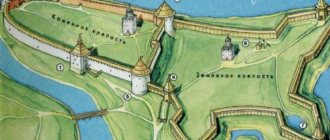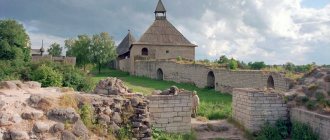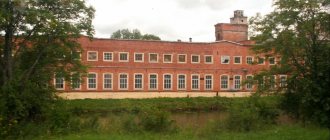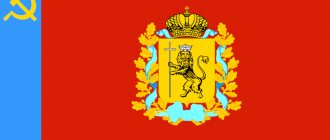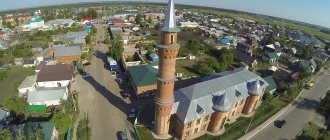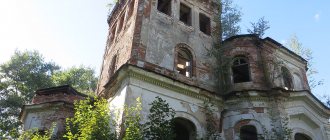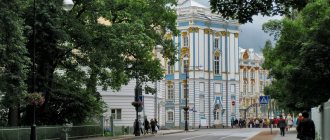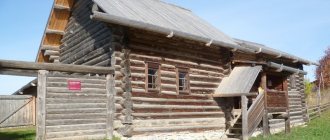Not far from St. Petersburg, on the banks of the Volkhov River there is the Staraya Ladoga fortress. This is one of the most ancient settlements in our country and, according to some historians, the first capital of Russia. Today Staraya Ladoga is formally considered only a small village. But for tourists who are interested in history, it certainly deserves a visit. In addition, almost the entire territory of Staraya Ladoga is a unique museum-reserve with preserved historical, cultural and architectural monuments of the 8th–19th centuries.
Even if you are not very interested in history and archeology, then you will like this corner of Russia with its beautiful picturesque places, where you will undoubtedly be able to feel the spirit of antiquity, relax and enjoy the beauty of nature.
How to get to Staraya Ladoga
- Staraya Ladoga is located in the lower reaches of the Volkhov River, 125 km from St. Petersburg.
- By car from St. Petersburg along the Kola highway, about 100 km. Turn to Staraya Ladoga and Myakinino.
- By train from Ladozhsky station to Volkhovstroy-1 station. Next take bus 23.
- By excursion bus from St. Petersburg
- In 2022, a pier was built in Staraya Ladoga near the Nikolsky Monastery, where ships on cruises along the rivers and lakes of Russia can stop. Most cruises depart from St. Petersburg. In addition to Staraya Ladoga, cruises include stops on the islands of Valaam and Konevets, the village of Mandrogi and others. The routes are very varied and last several days.
Natural attractions of Staraya Ladoga and its surroundings
The landscapes of the village and surrounding areas do not amaze with bright colors. But the modest natural beauty of the Leningrad region is no less attractive than the subtropics or savannahs. Tourists prefer to explore the natural attractions of Staraya Ladoga by car. Next to the village there is the Gorchakovshchinsky waterfall. Its height is 4.5 m. The waterfall is especially beautiful in spring, when it is widest, and in winter, when the water jets freeze and the natural attraction resembles the throne of the fairy-tale Snow Queen.
Not far from the village lie the “domains” of the Staraya Ladoga Nature Reserve. Its total area is 2.2 square meters. km. The reserve is famous for artificial caves formed in the century before last, when peasants mined quartz sand to make glass. Nature transformed the underground passages, filling them with streams and drips.
Of greatest interest to tourists coming to Staraya Ladoga are three caves: Staroladoga, Malyshka and Tanechkina. The length of the last of them is 7.5 km. Tanechkina Cave is known as a wintering place for bats.
Opening hours of the Staraya Ladoga Museum-Reserve in 2022
The museum is open to the public.
- During the winter period (September to May) Daily from 9:00 to 17:00
- Day off - January 1
- Every day from 9:00 to 18:00
Section materials
January 21, 10:54
Secrets of the Spill. With whom did Lenin live in a hut?
January 20, 12:43
The photo exhibition “Shchemilovka in Quarantine” will open at the Nevskaya Zastava Museum
January 14, 11:05
An exhibition of paintings and graphics by Vladimir Grinberg opened in St. Petersburg
January 13, 12:57
An exhibition about spiritualism at the turn of the 19th - 20th centuries opened at the Museum of the History of Religion
January 12, 11:47
The exhibition “Leningrad Childhood. 1920 - 1980s"
Cost of tickets to the Staraya Ladoga Museum-Reserve in 2022
- Entrance to the fortress territory For adults - 50 rubles
- For children under 16 years old - free
- For children from 16 to 18 years old, students of Russian universities and pensioners - 20 rubles
- For adults - 250 rubles
- For adults - 100 rubles
According to the Tale of Bygone Years, from 862 to 864 Staraya Ladoga served as the residence of Rurik, the legendary Scandinavian prince who laid the foundation for the famous Rurik dynasty. Therefore, we can say that during these years Staraya Ladoga was the ancient capital of Northern Rus'. For the next 20 years, Rurik reigned in Veliky Novgorod.
It should be noted that monuments of an earlier age were also found in the village, so the exact date of cutting down the logs from which one of the buildings was built was established; this find dates back to 753. It is this year that is accepted as the date of the founding of Staraya Ladoga.
Two well-known trade routes passed through Staraya Ladoga - “from the Varangians to the Greeks” and “from the Varangians to the Arabs”. Here, in the second half of the 8th century, the first money appeared; its role was played by beads made using Arab technology, and the value of such a bead was very great - you could buy a slave with it.
On the banks of the Volkhov there was a brisk trade - local residents sold furs brought from Scandinavia to the Arabs for silver dirhams. This is confirmed by both individual finds and treasures discovered during excavations.
In the Middle Ages, Staraya Ladoga served as an outpost of Russian lands, repelling the ferocious attacks of its northern neighbors. The first fortress was wooden; at the end of the 9th - beginning of the 10th century, the Varangians laid out a fortress wall with towers made of local limestone. The constructed settlement became the first stone fortress on the territory of Ancient Rus'.
With the founding of St. Petersburg in 1703, Staraya Ladoga found itself far from the border and lost its defensive significance. Historically, no major construction took place in the village, and to this day a cultural surface layer 2–5 meters deep, filled with archaeological finds, has been preserved here.
It is interesting that before Peter the Great the settlement was called Ladoga. In 1702, on the instructions of the emperor, not far from Staraya Ladoga, at the mouth of the Volkhov River, a shipbuilding shipyard was created, for which shipbuilders were resettled from the Russian North. In 1704, Peter founded the city of Novaya Ladoga here, and the former settlement began to be called Staraya Ladoga.
In 2003, the 1250th anniversary of Staraya Ladoga, the ancient capital of the Russian state, was solemnly celebrated.
In Staraya Ladoga you will explore historical, cultural and architectural monuments. The territory of the village is unique - in its entire history, only two percent of it has been excavated. While in Staraya Ladoga, you will walk through a layer of earth in which finds of wood and glass, bronze and iron, leather and fabric have been preserved.
The main attraction of Ladoga is the fortress, built in the place where the Ladozhka River flows into the Volkhov River. The fortification was of great importance for protecting the waterway from the Baltic Sea deep into Novgorod Rus'.
Currently, we will see only the fortress built here in the 16th century, although fragments of an earlier structure have also been preserved. The thickness of the fortress walls reaches 7 meters, and the height of the towers is 12 meters.
On the territory of the fortress there is a 12th-century St. George’s Church. Often this snow-white temple, crowned with only one dome, is called the Ladoga Bride. The church preserves a very unusual fresco dedicated to St. George. Most often, the Saint is depicted with a spear killing a serpent, but here he holds the banner of victory in his hand, and the pacified dragon allows the princess to behave on a leash.
Nikolsky Monastery was founded in honor of the victory of the Russian army over the Swedish in 1240. On the territory of the current monastery there is the Church of St. John Chrysostom of the second half of the 19th century with picturesque frescoes, as well as the St. Nicholas Church and the bell tower.
Be sure to walk along Varyazhskaya Street, famous for the fact that it was in this place that objects from the 9th–10th centuries were found. On Varyazhskaya Street you will see the symbol of the village - a small sculpture of a falcon made of bronze. There is also a chapel of the early 20th century and two museums - the Museum of Merchant Life and the Museum of Archeology of Ladoga.
The Staraya Ladoga Assumption Monastery was founded in 1156, and was first mentioned in the 15th century. Initially it was a men's monastery, later converted into a women's monastery. The monastery became a place of imprisonment for many famous women. So, in 1718, Evdokia Lopukhina, the first wife of Peter the Great, was brought here, and in the 19th century, relatives of the Decembrists were kept here. The main attraction of the monastery is the Assumption Cathedral, built in the 12th century - in the pre-Mongol period.
The Church of the Nativity of John the Baptist is located in the place where the St. John the Baptist Monastery was previously located. The temple stands out with its green domes; it seems to float between the earth and the sky. In the Church of the Nativity of John the Baptist, ancient frescoes have been preserved.
One of the attractions of Staraya Ladoga is Oleg’s grave, which is a large mound. According to legend, it was in Staraya Ladoga that the ancient Russian prince Oleg was buried. According to the Kyiv version, Prophetic Oleg is buried in Kyiv on Mount Shchekovitsa. Both legends say that the cause of the prince’s death was a snake bite.
According to legend, the Magi predicted the prince's death from his horse. Then Oleg ordered the animal to be taken away. A few years later, when the horse had already died, the prince came to his grave and grinned, remembering the prediction of the Magi. At that moment, a snake crawled out of the horse’s skull and bit Oleg.
In addition, there are caves in Staraya Ladoga, the largest of which is Tanechkina. Its length is more than 7 km. In one of its branches there is a lake 0.5 meters deep. Tanechkina Cave is also known for the fact that it is home to a huge flock of bats numbering more than 400 individuals.
Foundation of the museum
The Staraya Ladoga Museum was founded in August 1966, but received its first visitors five years later - in July 1971. Nowadays, the territory of the ancient city and its surroundings has been given the status of a historical, architectural and archaeological museum-reserve. The museum collections contain more than two hundred thousand different exhibits, including many fragments of destroyed murals. Museum exhibitions can be found not only directly in the halls of the museum building, but also in many monuments of ancient Russian architecture.
The archaeological collection of the Staraya Ladoga Museum-Reserve is rightfully considered one of the most interesting in Russia; exhibits from the museum collection have visited many European cities. From the very beginning of its foundation, the Staraya Ladoga Museum became the custodian of exhibits that were found as a result of archaeological excavations of the Staraya Ladoga expedition. The basis of the archaeological collection consists of objects that were extracted from cultural layers and funerary monuments of Staraya Ladoga, dating back to various eras. These include items made from various materials: iron, bronze, lead, glass. A number of finds that were discovered in the “wet” cultural layer are considered quite valuable - in soil that was well saturated with moisture, and therefore the objects found in it did not undergo such a strong decay process due to the low influx of oxygen. These are mainly exhibits made of organic materials - wood, leather, bone, horn and woven objects.
Museum exhibit
